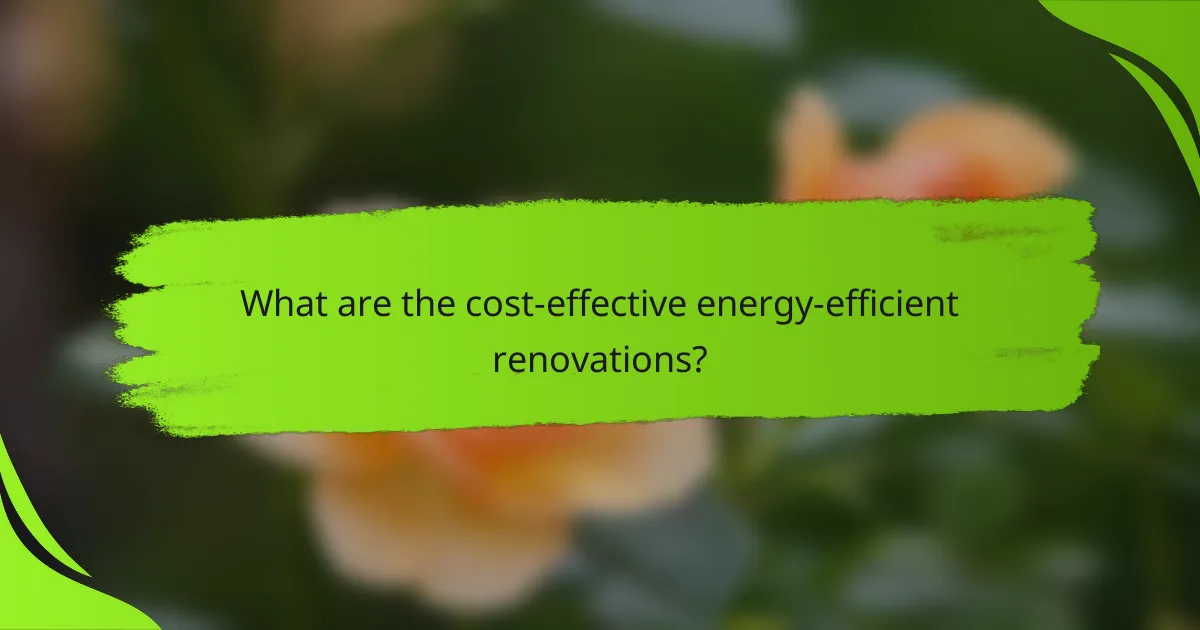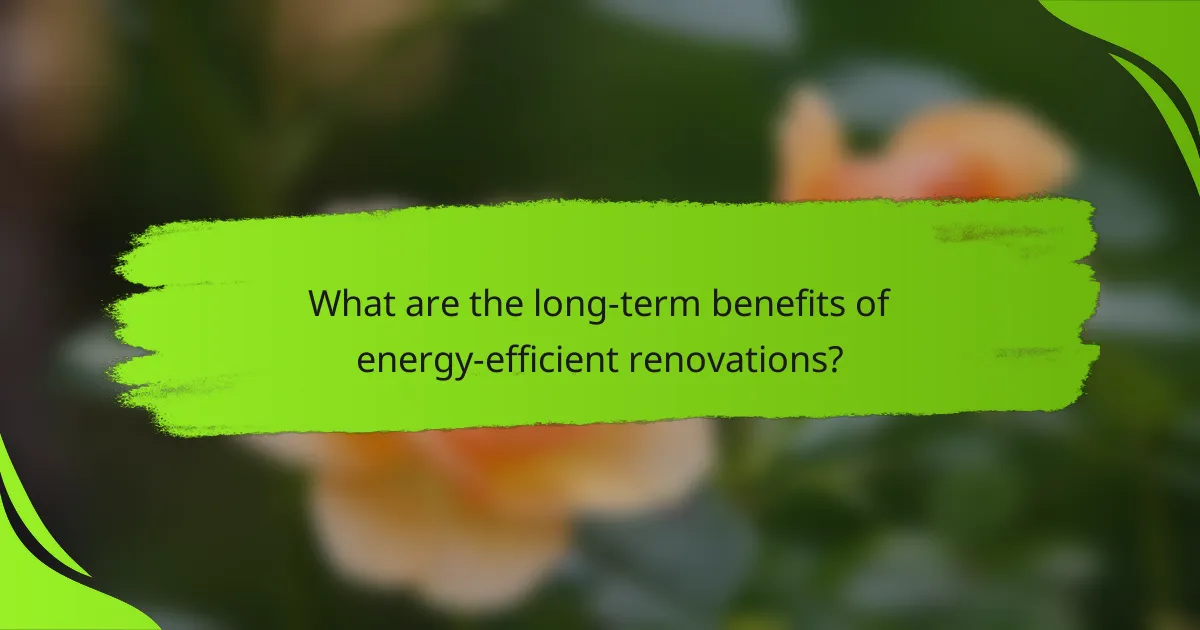Energy-efficient renovations offer homeowners a smart way to reduce energy consumption and lower utility bills while enhancing property value. By investing in upgrades such as improved insulation and energy-efficient windows, homeowners can enjoy long-term savings and comfort. Additionally, various incentives, including tax credits and rebates, can help offset initial costs, making these upgrades more attainable.

What are the cost-effective energy-efficient renovations?
Cost-effective energy-efficient renovations are home improvements that reduce energy consumption while providing savings on utility bills. These upgrades not only enhance comfort but can also increase property value and qualify homeowners for various incentives.
Insulation upgrades
Upgrading insulation is one of the most effective ways to improve energy efficiency. Proper insulation minimizes heat loss in winter and keeps homes cooler in summer, leading to lower heating and cooling costs. Consider materials like fiberglass, foam, or cellulose, which can significantly enhance thermal performance.
When planning insulation upgrades, focus on areas such as attics, walls, and basements. The initial investment can vary widely, but homeowners often see a return on investment through reduced energy bills within a few years.
Energy-efficient windows
Replacing old windows with energy-efficient models can greatly reduce heating and cooling costs. Look for windows with low U-factors and high solar heat gain coefficients, which indicate better insulation and energy performance. Double or triple-pane glass is a common choice.
While the upfront cost for energy-efficient windows can be substantial, many homeowners recoup their investment through energy savings and potential tax credits. In some regions, these upgrades can also improve comfort by reducing drafts.
Smart thermostats
Smart thermostats allow homeowners to optimize heating and cooling schedules based on their habits, leading to significant energy savings. These devices can learn preferences and adjust temperatures automatically, ensuring comfort while minimizing energy use.
Installation is generally straightforward, and many models are compatible with existing HVAC systems. Homeowners can expect savings of around 10-15% on heating and cooling bills, making smart thermostats a cost-effective upgrade.
Solar panel installation
Installing solar panels can provide substantial long-term savings on electricity bills. By converting sunlight into energy, homeowners can reduce reliance on grid power and potentially eliminate monthly electricity costs. The initial investment can be offset by federal and state incentives.
Before installation, assess your roof’s orientation and shading to ensure maximum efficiency. Many homeowners find that financing options and tax credits make solar panels more accessible, leading to a payback period of 5-10 years in many cases.
High-efficiency HVAC systems
Upgrading to a high-efficiency HVAC system can dramatically lower energy consumption. Look for systems with a high Seasonal Energy Efficiency Ratio (SEER) rating, which indicates better efficiency. These systems often come with advanced features like variable-speed motors and smart controls.
While the initial cost may be higher than standard units, the long-term savings on energy bills can be significant. Homeowners should consider the total cost of ownership, including maintenance and potential rebates, when evaluating their options.

How do energy-efficient renovations impact savings?
Energy-efficient renovations can significantly lower your utility costs while enhancing the overall value of your property. By investing in upgrades like better insulation, energy-efficient windows, and modern heating systems, homeowners can enjoy substantial savings over time.
Reduced utility bills
One of the most immediate benefits of energy-efficient renovations is the reduction in utility bills. For instance, upgrading to energy-efficient appliances can cut electricity consumption by 10-50%, depending on the appliance type. Additionally, improved insulation can lower heating and cooling costs by up to 30%.
To maximize savings, consider conducting an energy audit to identify the most cost-effective upgrades. This assessment can help prioritize renovations that will yield the highest return on investment.
Increased property value
Energy-efficient renovations often lead to an increase in property value. Homes with energy-efficient features can sell for 5-15% more than similar homes without these upgrades. Buyers are increasingly looking for properties that promise lower utility costs and a smaller carbon footprint.
When planning renovations, focus on high-impact improvements like solar panels or energy-efficient HVAC systems, as these tend to attract more buyers and can justify a higher asking price.
Long-term financial benefits
In addition to immediate savings, energy-efficient renovations offer long-term financial benefits. Over the lifespan of energy-efficient upgrades, homeowners can save thousands of dollars in utility costs. For example, investing in solar panels may have a payback period of 5-10 years, after which electricity costs can be significantly reduced or even eliminated.
Furthermore, many regions offer tax incentives or rebates for energy-efficient renovations, which can offset initial costs. Research local programs to take full advantage of available financial support, enhancing the overall return on your investment.

What incentives are available for energy-efficient renovations in the US?
In the US, various incentives exist to encourage energy-efficient renovations, including federal tax credits, state rebates, and local utility programs. These incentives can significantly reduce the upfront costs of energy-saving improvements, making them more accessible for homeowners.
Federal tax credits
Federal tax credits are available for homeowners who make qualifying energy-efficient upgrades to their residences. These credits can cover a percentage of the costs associated with improvements like solar panels, energy-efficient windows, and HVAC systems. For example, the Residential Energy Efficiency Property Credit allows homeowners to claim a credit for a portion of the installation costs of renewable energy systems.
To take advantage of these credits, ensure that your renovations meet the specific criteria set by the IRS. It’s advisable to keep all receipts and documentation related to the improvements, as you will need them when filing your taxes.
State rebates
Many states offer rebates for energy-efficient renovations, which can further offset costs. These rebates vary widely by state and can cover a range of improvements, from insulation to energy-efficient appliances. For instance, some states may provide rebates that range from a few hundred to several thousand dollars, depending on the type of upgrade and its energy savings.
Check your state’s energy office or website for specific programs and eligibility requirements. Applying for these rebates often involves submitting proof of purchase and documentation of the energy savings achieved.
Local utility programs
Local utility companies frequently have programs designed to promote energy efficiency among their customers. These programs may include rebates for energy-efficient appliances, home energy audits, and incentives for participating in energy-saving initiatives. Utility incentives can vary significantly, so it’s beneficial to contact your local provider to learn about available options.
Participating in these programs can lead to immediate savings on your utility bills, as well as potential rebates that help recoup renovation costs. Be sure to inquire about any deadlines or specific requirements to maximize your benefits.

What are the long-term benefits of energy-efficient renovations?
Energy-efficient renovations provide significant long-term benefits, including reduced utility bills, improved property value, and a smaller environmental footprint. These upgrades can lead to substantial savings over time while enhancing the overall living experience.
Environmental impact
Energy-efficient renovations contribute to a lower carbon footprint by reducing energy consumption. By using sustainable materials and technologies, homeowners can minimize waste and decrease reliance on fossil fuels. For instance, installing solar panels or energy-efficient appliances can significantly cut greenhouse gas emissions.
Additionally, many regions offer incentives for eco-friendly renovations, which can further encourage homeowners to adopt sustainable practices. These incentives may include tax credits, rebates, or grants aimed at promoting energy efficiency.
Improved indoor air quality
Renovations that focus on energy efficiency often lead to better indoor air quality. Upgrading insulation, sealing leaks, and using low-VOC (volatile organic compounds) materials can reduce pollutants and allergens in the home. This is particularly beneficial for individuals with respiratory issues or allergies.
Implementing proper ventilation systems can also help maintain fresh air circulation, further enhancing the indoor environment. Homeowners should consider using energy recovery ventilators (ERVs) to efficiently exchange stale indoor air with fresh outdoor air without losing energy.
Enhanced comfort
Energy-efficient renovations can significantly enhance comfort levels within a home. Improved insulation and energy-efficient windows help maintain consistent indoor temperatures, reducing drafts and cold spots. This leads to a more enjoyable living environment throughout the year.
Moreover, energy-efficient heating and cooling systems can operate more quietly and effectively, contributing to a peaceful atmosphere. Homeowners should evaluate options like programmable thermostats to optimize energy use and comfort simultaneously.

What factors should be considered before renovating?
Before renovating for energy efficiency, consider your budget, the results of a home energy audit, and local building codes. These factors will help you make informed decisions that balance costs with potential savings and compliance with regulations.
Budget constraints
Your budget is a critical factor in any renovation project. Determine how much you can allocate for energy-efficient upgrades, keeping in mind that initial costs may be higher than traditional options. Aim for a budget that allows for a mix of essential and optional improvements.
Consider financing options such as low-interest loans or grants that may be available for energy-efficient renovations. These can help spread costs over time, making it easier to manage your budget while still achieving significant energy savings.
Home energy audit results
A home energy audit provides valuable insights into where your home is losing energy and which upgrades will yield the best results. Look for recommendations on insulation, windows, and HVAC systems that can significantly improve efficiency.
Prioritize renovations based on the audit findings. For example, if the audit indicates that your insulation is inadequate, addressing this issue first could lead to immediate energy savings, making other upgrades more effective in the long run.
Local building codes
Local building codes dictate the standards for renovations, including energy efficiency requirements. Familiarize yourself with these regulations to ensure your renovations comply and avoid potential fines or the need for costly modifications later.
Check for any incentives or rebates that may be tied to meeting specific energy efficiency standards set by local authorities. These can help offset renovation costs while ensuring that your upgrades are compliant with local laws.
